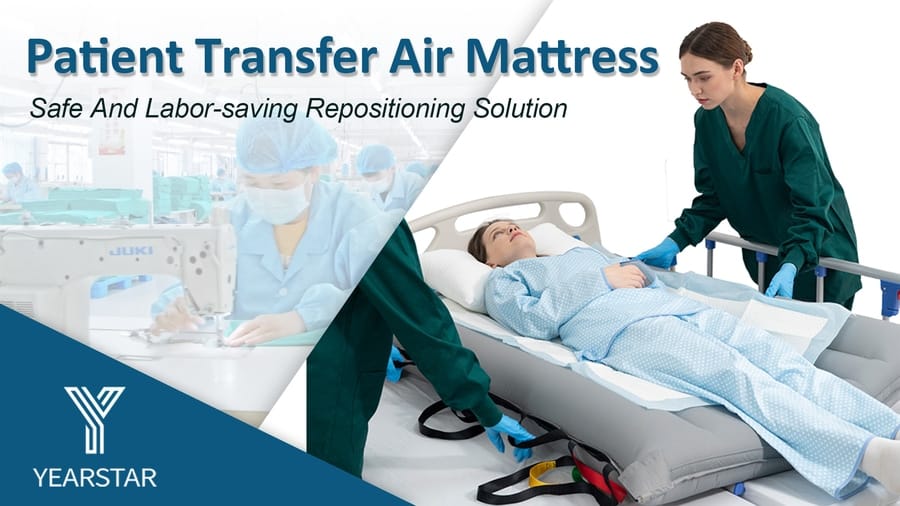In the ever-evolving landscape of modern healthcare, innovations that enhance patient care and caregiver well-being are highly valued. One such innovation making a significant impact is the air transfer mattress. But what exactly is an air transfer mattress, and how does it revolutionize patient handling practices? This post will provide a comprehensive overview, explaining the fundamentals of air transfer mattress technology and exploring its transformative effects on healthcare settings.
1. Deconstructing the Air Transfer Mattress: A Definition
An air transfer mattress, also commonly referred to as an air-assisted lateral transfer device or air flotation mattress, is a specialized medical device engineered to safely and efficiently move patients between surfaces, such as beds, stretchers, operating tables, and imaging equipment. Unlike traditional methods that rely on manual lifting and pulling, air transfer mattresses utilize the power of air flotation technology.
2. The Science Behind the Revolution: How Air Flotation Works
The core of the air transfer mattress revolution lies in its ingenious application of air flotation principles. Here’s a step-by-step explanation of how it works:
- Inflation System: An external air compressor or blower inflates the mattress with air.
- Air Cushion Creation: As the mattress inflates, it creates a pressurized cushion of air underneath the patient.
- Perforated Mattress Surface: The underside of the mattress is designed with numerous small perforations or air outlets.
- Even Air Distribution: Air is evenly distributed through these perforations, creating a consistent layer of air between the mattress and the supporting surface (bed, stretcher etc.).
- Near-Frictionless Transfer: This thin layer of air effectively eliminates most of the friction between the patient and the surface, creating a near-frictionless plane.
- Effortless Patient Movement: Caregivers can then glide, slide, and reposition the patient laterally with minimal force and physical strain.
3. Revolutionizing Patient Handling: Key Impacts of Air Transfer Mattresses
Air transfer mattresses are not simply an incremental improvement; they represent a fundamental shift in how patient handling is approached. Here’s how they are revolutionizing the field:
- Enhancing Patient Safety:
- Reducing Shear and Friction: By eliminating friction, air transfer mattresses significantly minimize the risk of skin tears, bruising, and pressure ulcers during transfers.
- Minimizing Fall Risk: The stable and controlled nature of air-assisted transfers reduces the likelihood of patients falling during movement.
- Improving Patient Comfort: The smooth gliding motion is more comfortable and less jarring for patients, especially those with pain, fragile skin, or limited mobility.
- Promoting Dignity: Air transfer mattresses facilitate more dignified and less physically intrusive transfers, respecting patient comfort and privacy.
- Transforming Caregiver Ergonomics:
- Significantly Reducing Physical Strain: Air flotation minimizes manual lifting, pulling, and pushing forces, dramatically reducing the ergonomic burden on caregivers.
- Preventing Musculoskeletal Injuries (MSIs): By reducing strain, air transfer mattresses directly combat the leading cause of MSIs among healthcare workers, such as back injuries and shoulder strains.
- Improving Caregiver Well-being: Reduced physical demands contribute to less caregiver fatigue, burnout, and improved job satisfaction.
- Extending Caregiver Careers: By preventing injuries, air transfer mattresses can contribute to longer, healthier careers for nurses and other healthcare professionals.
- Boosting Workflow Efficiency:
- Faster and Smoother Transfers: Air-assisted transfers are generally much quicker than manual methods, saving valuable time in busy healthcare settings.
- Optimizing Staffing Allocation: Often requiring fewer caregivers per transfer, air mattresses allow for better allocation of staff resources and improved efficiency.
- Streamlining Processes: Air transfer mattresses simplify patient handling procedures, leading to more streamlined workflows and reduced delays.
- Increasing Throughput: Faster transfers can contribute to improved patient throughput, especially in high-demand areas like emergency departments and operating rooms.
4. Diverse Applications in Healthcare Settings
The versatility of air transfer mattresses makes them applicable across a wide range of healthcare environments:
- Hospitals: Medical-surgical units, intensive care units (ICUs), operating rooms (ORs), emergency departments (EDs), radiology departments, and more.
- Long-Term Care Facilities: Nursing homes, skilled nursing facilities, and assisted living facilities.
- Rehabilitation Centers: Inpatient and outpatient rehabilitation facilities.
- Home Healthcare: For patient transfers within the home setting, improving safety for both patients and home caregivers.
- Emergency Medical Services (EMS): In ambulances and pre-hospital settings for rapid and safe patient transfers.
- Bariatric Care: Particularly beneficial for safely and efficiently handling larger and heavier patients.
5. The Future of Patient Handling is Air-Assisted
Air transfer mattresses are rapidly becoming recognized as a standard of care in modern healthcare. Their ability to simultaneously enhance patient safety, improve caregiver ergonomics, and boost workflow efficiency positions them as a transformative technology. As healthcare continues to evolve, air transfer mattresses are poised to play an increasingly crucial role in creating safer, more efficient, and more compassionate care environments for both patients and providers alike.

